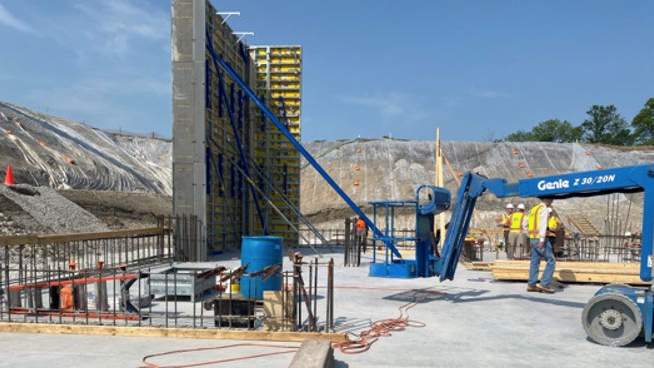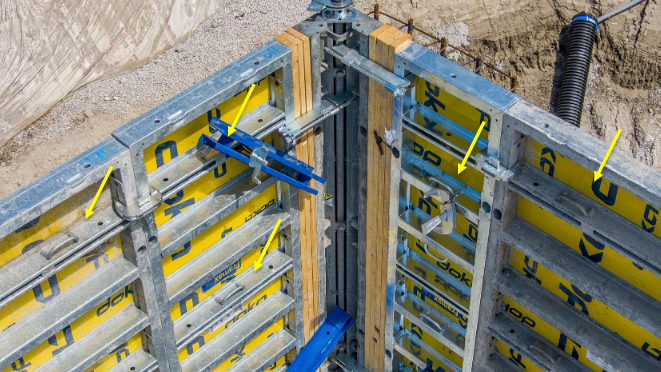Safety
Federal Report Proposes Changes After Fermilab Worker's Fall
Construction is paused at LINAC building site—a portion of the $978-million PIP-II project in Illinois

A screengrab censored by the Dept. of Energy from video of the construction site shows James Daniels working near the top of a formwork corner shortly before his fall.
Image courtesy of U.S. Dept. of Energy Office of Science
Construction of a portion of the $978-million PIP-II project at Fermi National Accelerator Laboratory in Batavia, Ill., has been shut down since May 25, when an ironworker, not tied off, was seriously injured in a fall. The incident is now the focus of a lawsuit brought by the worker, as well as a nearly 200-page U.S. Dept. of Energy report identifying safety lapses and recommending changes to prevent similar incidents.
Investigators with the DOE Office of Science propose adding hazard controls and field verification to ensure safety compliance, before construction resumes.
Fermi Research Alliance, which operates the particle physics research site Fermilab under a contract with DOE, has developed a phased restart plan, according to Tracy Marc, a spokesperson for FRA.
Fermilab is working with its contractors at the site office “to ensure a thorough plan is in place and appropriate steps are taken prior to restarting the construction work,” Marc says in an email.
The work is part of Fermilab’s Proton Improvement Plan II (PIP-II), and officials say it would upgrade the lab’s particle accelerator to accommodate future research. The accident took place during construction of the Linear Accelerator, or LINAC, complex, which would include an 800-million-electronvolt superconducting radio frequency linear accelerator to increase available power for experiments.
The LINAC building represents less than 10% of the entire PIP-II project and other technical component work is proceeding as planned during the construction pause, notes Marc.
Whittaker Construction and Excavation Inc. of Earlville, Ill., is FRA’s firm fixed-price contractor for the LINAC project. Whittaker subcontracted with Bourbonnais, Ill.-based Nucor Harris Rebar Midwest LLC for form and concrete preparation work, and Nucor Harris subcontracted with affiliate Harris Rebar Placing LLC of Milford, Mass., for the installation of reinforcing steel and couplers.
According to the DOE report, the accident occurred on May 25 as ironworkers were attaching a rebar template, also known as a rebar cage, to the side of a 26.5-ft-tall formwork wall for the LINAC building. One worker, identified in his lawsuit as James Daniels, was alone about 23 ft up on the inside of the formwork’s northwest corner while three other workers were on the other side, preparing to raise a rebar template into place, which Daniels would have then secured with ties inserted from his side of the wall.
Daniels, a journeyman ironworker who was employed by Harris Rebar Placing, accused Whittaker and FRA of construction negligence in a lawsuit filed in a state court in Chicago.
No one witnessed the fall, but investigators were able to watch the entire incident on video recorded by a camera on a building near the site. Daniels had climbed the horizontal ribs of the formwork, and had one foot on a horizontal rib on the north form wall and one foot on a rib on the west wall. While repositioning himself, Daniels fell from the wall, striking a diagonal cross brace about half way down and then landing on a concrete slab.
A medical helicopter crew flew Daniels to a hospital in Chicago, according to the report. Michael Fisher, an attorney representing Daniels, says Daniels suffered a traumatic brain injury and was in a coma for almost a month. Doctors initially had trouble getting Daniels to breathe on his own. He then spent about a month as an inpatient at Shirley Ryan AbilityLab, and is still being treated there as an outpatient. Daniels continues to have significant problems with one of his arms, which is not responding to treatment and is mostly unusable, Fisher adds.
“We’re hoping that they start to make some progress with that, but it has gone very slowly and is not going well,” he says. “So this looks like a significant lifetime disability.”
Not Tied Off
Daniels was wearing a fall protection harness, but was not tied off, according to the DOE report. Investigators were not clear on the reason that Daniels was not tied off.
Fisher says Daniels currently has no recollection of the events leading up to his fall or the fall itself because of his injuries.
It’s also not clear exactly why Daniels fell. The report identified broad contributing causes. Lack of fall protection was primary. Investigators also wrote that requirements were not being implemented as expected, the direction of work was not clear, applicable hazards had not been defined and applicable controls had not been developed or implemented.
 Investigators say ironworkers had access to a lift, but Daniels did not use it. Photo courtesy U.S. Dept. of Energy Office of Science
Investigators say ironworkers had access to a lift, but Daniels did not use it. Photo courtesy U.S. Dept. of Energy Office of ScienceIn the lawsuit, attorneys for Daniels wrote that Whittaker and FRA failed to provide and require adequate fall protection. Fisher says the horizontal metal bars on the formwork being used as foot holds are only 3 in. deep, less than the depth of an OSHA-compliant ladder rung, and the space behind them does not allow for proper or safe foot bearing.
The report notes that an aerial lift was located nearby. Other ironworkers had used the lift in the days prior to Daniels’ fall. Fisher says the supervisors and safety personnel from Whittaker and FRA never directed Daniels to use the lift.
There were horizontal metal bars near the top of the formwork, but Fisher says the one to Daniels’ left was covered by a brace, and the one to his right was more than 3 ft away and would have required him to stretch outside his body frame to reach it. Daniels was never trained or instructed that those bars were designated anchor points, he adds.
 An attorney for Daniels says handles on the formwork were covered by a brace or beyond his reach. Photo courtesy U.S. Dept. of Energy Office of Science
An attorney for Daniels says handles on the formwork were covered by a brace or beyond his reach. Photo courtesy U.S. Dept. of Energy Office of Science
Also, Fisher says the ironworkers were not trained in the erection of the formwork or provided the user manual. The instructions call for designated anchors to be used as tie-off points. However, those points needed to be installed into the forms. None were used on the job, he says.
“A $70 vertical safety line, running from the top of the form to the ground, would have provided an OSHA-compliant anchor point that would have provided fall protection 100% of the time for James and the ironworkers,” Fisher says. “None was provided or designated by the layers of supervisors and safety personnel working for the defendants.”
Marc said FRA could not comment on pending litigation and Whittaker Construction did not immediately respond to inquiries. But in answers that FRA and Whittaker respectively filed to Daniels’ lawsuit, they deny the allegations against them. They placed blame on Daniels for failing to tie off his fall protection equipment, failing to follow safety rules and for climbing the formwork without asking for assistance or instructions for clarification, if he needed it.
“Daniels had a duty to exercise reasonable care for his own safety while performing work on the project,” attorneys for Whittaker wrote.
Preventing Similar Incidents
The DOE report identified 23 conclusions and 12 judgments of need from the investigation that officials say could prevent similar incidents in the future. FRA requires its contractors to follow the Energy Dept. regulation for worker safety and health. However, investigators concluded that there were a variety of failures in identifying hazards, mitigating previous deficiencies and implementing safety practices on this project.
The investigators recommend ensuring that those hazards are identified, controls are developed and field verification ensures compliance with safety plans. The report does not detail how to better implement those plans than what already had been in place, offering just a sentence for each of the judgments of need.
Marc said “FRA will review all aspects of the incident report and implement a thorough corrective action plan as it works to improve safe and secure operations across the laboratory, including work on our construction projects.”




